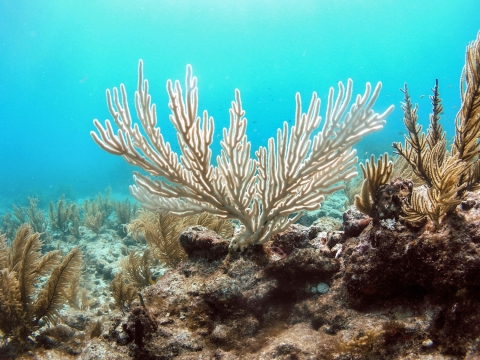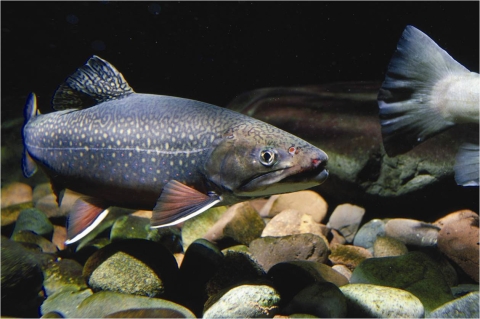In the southeastern United States, changes to the climate are having profound impacts on our nation’s wildlife and habitats. In aquatic environments, evidence is growing that higher water temperatures resulting from climate change are negatively impacting cold- and cool-water fish populations across the country. Warmer winters are changing some birds’ migratory patterns. Sooty terns, which nest in the Dry Tortugas off Key West, Florida, are showing up earlier and earlier. Roseate spoonbills, which generally stay in Florida, the Gulf Coast and points south, are now regularly spotted in South Carolina. Record warm seawater is linked to coral reef bleaching in the Florida Keys and Puerto Rico.
There are 67 southeastern national wildlife refuges from Louisiana to North Carolina situated along coasts. Rising sea levels are expected to flood as much as 30% of the habitat on our coastal national wildlife refuges, potentially displacing protected wildlife. Some places most vulnerable places to sea level rise are found in the Mississippi Delta, the Florida Keys, the Everglades, and the North Carolina coast.
Read more information on our nationwide approach to climate change.
Video
Landscape level changes require landscape level partnerships
The U.S. Fish and Wildlife Service cannot face the climate challenge alone. Neither can a state, a nonprofit organization or a university system. Climate change demands more of us all, working together. The nationwide network of Landscape Conservation Cooperatives are the centerpiece of our response.
Landscape Conservation Cooperatives (LCCs) are scientific partnerships designed to assess and help tackle the biggest conservation challenges of the 21st century.
In order to ensure the sustainability of our economy, land, water, wildlife and cultural resources, LCCs gather together experts from universities, businesses, nonprofits, local, state and federal governments in similar geographic areas.
Get started with Southeastern LCCs
- South Atlantic: Serving Atlantic coast states from southern Virginia, North Carolina, South Carolina, Georgia to north Florida.
- Gulf Coastal Plains and Ozarks: Serving south and west Alabama, Mississippi, Louisiana, eastern corners of Texas and Oklahoma, Arkansas, southern Missouri, west Tennessee and the western corner of Kentucky.
Peninsular Florida: Serving the majority of the state and the Florida keys.
Caribbean: Serving Puerto Rico and the U.S. Virgin Islands. Follow us on Facebook and Twitter.
Appalachian: Serving the Appalachian mountain range, covering portions of Georgia, Alabama, South Carolina, North Carolina, Kentucky, Tennessee, Virginia, Maryland, Ohio, Pennsylvania and New York.
Gulf Coast Prairie: Serving middle and coastal Texas, Mexico and part of Oklahoma
Contact
Bill Uihlein, Assistant Regional Director for Science Applications
Carbon sequestration for wildlife
Carbon dioxide is one of many gases emitted into the atmosphere that contribute to climate change. Terrestrial carbon sequestration is a natural process in which plants take in carbon dioxide from the atmosphere and store, or sequester, it in woody vegetation for decades or more. This process helps to reduce the harmful effects of carbon dioxide emissions.
The U.S. Fish and Wildlife Service is partnering with dozens of private corporations and government and non-government organizations, to increase the benefits of carbon sequestration by restoring and enhancing native forest and wildlife habitat on national wildlife refuges and other lands in the southeast. More than 65,000 acres of federal and privately owned lands have been restored in the region since 1992, benefiting wildlife and sequestering carbon for future carbon credits.
Our efforts to sequester greenhouse gases have multiple benefits, such as:
- National wildlife refuges offer established forests and land for reforestation to help trap greenhouse gases;
- Native reforestation of open land creates new habitat for many species we are striving to conserve;
- Cooperative projects create new funding sources for vital projects, particularly during times of constrained budgets;
- Past damages to the ecosystem can be reversed by utilizing science and wildlife conservation principles.
This approach also ensures that carbon sequestration projects truly benefit our native wildlife populations - an important goal of both the Service and the conservation community!
Our earth, its land and its oceans, are more than just a storage container for greenhouse gases. The Service’s partnerships with industry and conservation organizations will result in terrestrial carbon sequestration projects that conserve, restore, and maintain the ecological integrity of our nation’s land, water, and native habitats for fish and wildlife.
Download our carbon sequestration fact sheet.





